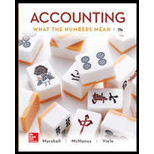
Concept explainers
Concept Introduction:
Accounting equation represents the mathematical relationship between assets, liabilities and equity. According to this equation, assets are equal to the sum of liabilities and equity. The formal for basic accounting equation is as follows:
Requirement-1:
To indicate:
The effect of the purchase of supplies as expense using the horizontal model
Concept Introduction:
Adjusting entries: The adjusting entries are recorded at the end to each accounting period to adjust the account as per the accrual concept of accounting. The adjusting entries include adjustment of depreciation, adjustment of payable expenses, and adjustment of receivable revenue.
Accounting equation represents the mathematical relationship between assets, liabilities and equity. According to this equation, assets are equal to the sum of liabilities and equity. The formal for basic accounting equation is as follows:
Requirement-2:
To indicate:
The effect of the adjustment for supplies using the horizontal model
Concept Introduction:
Adjusting entries: The adjusting entries are recorded at the end to each accounting period to adjust the account as per the accrual concept of accounting. The adjusting entries include adjustment of depreciation, adjustment of payable expenses, and adjustment of receivable revenue.
Accounting equation:
Accounting equation represents the mathematical relationship between assets, liabilities and equity. According to this equation, assets are equal to the sum of liabilities and equity. The formal for basic accounting equation is as follows:
Requirement-3:
To indicate:
The effect of the alternative way of recording the supplies purchase using the horizontal model
Concept Introduction:
Adjusting entries: The adjusting entries are recorded at the end to each accounting period to adjust the account as per the accrual concept of accounting. The adjusting entries include adjustment of depreciation, adjustment of payable expenses, and adjustment of receivable revenue.
Accounting equation:
Accounting equation represents the mathematical relationship between assets, liabilities and equity. According to this equation, assets are equal to the sum of liabilities and equity. The formal for basic accounting equation is as follows:
Requirement-d:
To indicate:
The effect of the adjustment required using the alternative way of recording the supplies purchase using the horizontal model
Concept Introduction:
Adjusting entries: The adjusting entries are recorded at the end to each accounting period to adjust the account as per the accrual concept of accounting. The adjusting entries include adjustment of depreciation, adjustment of payable expenses, and adjustment of receivable revenue.
Accounting equation:
Accounting equation represents the mathematical relationship between assets, liabilities and equity. According to this equation, assets are equal to the sum of liabilities and equity. The formal for basic accounting equation is as follows:
Requirement-e:
To indicate:
The effect of the above two different set of ways to record the supplies expense on the income statement and the balance sheet
Want to see the full answer?
Check out a sample textbook solution
Chapter 4 Solutions
Accounting: What the Numbers Mean

 AccountingAccountingISBN:9781337272094Author:WARREN, Carl S., Reeve, James M., Duchac, Jonathan E.Publisher:Cengage Learning,
AccountingAccountingISBN:9781337272094Author:WARREN, Carl S., Reeve, James M., Duchac, Jonathan E.Publisher:Cengage Learning, Accounting Information SystemsAccountingISBN:9781337619202Author:Hall, James A.Publisher:Cengage Learning,
Accounting Information SystemsAccountingISBN:9781337619202Author:Hall, James A.Publisher:Cengage Learning, Horngren's Cost Accounting: A Managerial Emphasis...AccountingISBN:9780134475585Author:Srikant M. Datar, Madhav V. RajanPublisher:PEARSON
Horngren's Cost Accounting: A Managerial Emphasis...AccountingISBN:9780134475585Author:Srikant M. Datar, Madhav V. RajanPublisher:PEARSON Intermediate AccountingAccountingISBN:9781259722660Author:J. David Spiceland, Mark W. Nelson, Wayne M ThomasPublisher:McGraw-Hill Education
Intermediate AccountingAccountingISBN:9781259722660Author:J. David Spiceland, Mark W. Nelson, Wayne M ThomasPublisher:McGraw-Hill Education Financial and Managerial AccountingAccountingISBN:9781259726705Author:John J Wild, Ken W. Shaw, Barbara Chiappetta Fundamental Accounting PrinciplesPublisher:McGraw-Hill Education
Financial and Managerial AccountingAccountingISBN:9781259726705Author:John J Wild, Ken W. Shaw, Barbara Chiappetta Fundamental Accounting PrinciplesPublisher:McGraw-Hill Education





